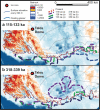Wilkes subglacial basin ice sheet response to Southern Ocean warming during late Pleistocene interglacials
- PMID: 36088458
- PMCID: PMC9464198
- DOI: 10.1038/s41467-022-32847-3
Wilkes subglacial basin ice sheet response to Southern Ocean warming during late Pleistocene interglacials
Erratum in
-
Author Correction: Wilkes subglacial basin ice sheet response to Southern Ocean warming during late Pleistocene interglacials.Nat Commun. 2022 Oct 26;13(1):6380. doi: 10.1038/s41467-022-34002-4. Nat Commun. 2022. PMID: 36289216 Free PMC article. No abstract available.
Abstract
The response of the East Antarctic Ice Sheet to past intervals of oceanic and atmospheric warming is still not well constrained but is critical for understanding both past and future sea-level change. Furthermore, the ice sheet in the Wilkes Subglacial Basin appears to have undergone thinning and ice discharge events during recent decades. Here we combine glaciological evidence on ice sheet elevation from the TALDICE ice core with offshore sedimentological records and ice sheet modelling experiments to reconstruct the ice dynamics in the Wilkes Subglacial Basin over the past 350,000 years. Our results indicate that the Wilkes Subglacial Basin experienced an extensive retreat 330,000 years ago and a more limited retreat 125,000 years ago. These changes coincide with warmer Southern Ocean temperatures and elevated global mean sea level during those interglacial periods, confirming the sensitivity of the Wilkes Subglacial Basin ice sheet to ocean warming and its potential role in sea-level change.
© 2022. The Author(s).
Conflict of interest statement
The authors declare no competing interests.
Figures





References
Publication types
MeSH terms
LinkOut - more resources
Full Text Sources
Miscellaneous

